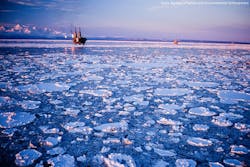US Interior finalizes Arctic exploratory drilling regulations
The US Department of the Interior on July 7 announced final regulations for exploratory drilling activities on the US Arctic Outer Continental Shelf (OCS) that require firms to have plans in place should a safety or environmental issue arise during operations (OGJ Online, Feb. 20, 2015).
The final rule focuses solely on floating vessels within the US Beaufort and Chukchi seas, requiring firms to implement proper internal controls and planning for oil-spill prevention, containment, and responses—issues identified by previous Interior reports on Royal Dutch Shell PLC’s 2012 exploration activities in the Arctic (OGJ Online, Mar. 15, 2013).
The changes complement the final well-control rule released in April (OGJ Online, Apr. 15, 2016). While that rule applies across the entirety of the OCS, including the Arctic, many of the provisions of the final Arctic regulations go beyond the scope of the well-control rule and address the challenges posed by the Arctic operating environment.
Integrated operations plan
Specifically, the final rule requires operators to develop an integrated operations plan addressing all phases of a proposed Arctic exploration program and submit it to the US Bureau of Ocean Energy Management (BOEM) before filing an exploration plan. The regulations require companies to have access to—and the ability to promptly deploy—source-control and containment equipment, such as capping stacks and containment domes, while drilling below or working below the surface casing.
Operators also must have access to a separate relief rig able to drill a timely relief well under the conditions expected at the site in the event of a loss of well control; have the capability to predict, track, report, and respond to ice conditions and adverse weather events; effectively manage and oversee contractors; and develop and implement an oil-spill response plan designed and executed in a manner that accounts for the Arctic operating environment, and is supported with the necessary equipment, training, and personnel for oil-spill response on the Arctic OCS.
Interior units BOEM and the Bureau of Safety and Environmental Enforcement developed the regulations with public input from the State of Alaska, North Slope communities, Alaska Native tribes and organizations, industry, and nongovernmental organizations. An environmental assessment, pursuant to the National Environmental Policy Act, was also prepared in conjunction with the rule, and more than 100,000 individual comments were received on the notice of proposed rulemaking.
Interior notes that operators continue to hold a number of active leases in the Beaufort Sea planning area and one in the Chukchi Sea planning area. Over the past year, Shell exited the US Arctic after “disappointing” results from its Burger J exploration well in the Chukchi Sea (OGJ Online, Sept. 28, 2015). Statoil ASA followed suit in November, vacating its own leases in the Chukchi Sea (OGJ Online, Nov. 17, 2015).
Further, the agency in October 2015 cancelled the two potential Arctic offshore lease sales scheduled under the leasing program for 2012-17 (OGJ Online, Oct. 16, 2015).
‘An unfortunate turn’
“This is an unfortunate turn by this administration and will continue to stifle offshore oil and natural gas production,” said Erik Milito, American Petroleum Institute upstream and industry operations director, in a statement following the rule’s publication. “We remain concerned about various regulatory activities related to offshore energy development including today’s proposals for Arctic operations.
“The US oil and natural gas industry has a proven track record of working with the federal government to improve offshore safety,” he said. “Certain proposed requirements may not improve safety and in fact may inhibit innovation and technological advancements. Any regulations that are published should achieve the objectives of protecting workers and the environment and promoting energy development.”
API cited a 2015 report from the National Petroleum Council, conducted at the request of the US Secretary of Energy, that determined oil and gas “exploration and development in the Arctic is extensively regulated,” and “progressing offshore development in the Arctic would require around 60 permit types through 10 federal agencies.”
Randall Luthi, president of the National Ocean Industries Association, also lamented the prescriptive requirements. “Despite taking years to write, the rule does not accurately reflect current industry capabilities and includes unnecessary requirements, such as same season relief wells, which may not be needed due to the availability of new response and containment equipment,” he commented in a separate statement.
“The offshore industry has shown that oil and natural gas development can be done safely in Arctic conditions,” Luthi continued. “Even as we review the provisions of this rule, other countries—including Canada, Greenland, Russia, and Norway—are already taking steps to explore and develop Arctic OCS resources.”
Arctic Energy Center spokesperson Lucas Frances noted that “even though the administration has aggressively pursued a policy that restricts oil and gas development, today’s regulations do signify its recognition that America’s largest energy opportunity—the offshore Arctic—can be explored safely and responsibly.” He added that it’s critical the administration “now acknowledges the importance of Arctic offshore resources and includes the region in the forthcoming offshore leasing program.”
Contact Matt Zborowski at [email protected].


